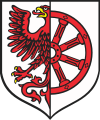Cedynia
| Cedynia | ||
|---|---|---|
| ||
 Cedynia | ||
| Coordinates: 52°53′N 14°12′E / 52.883°N 14.200°E | ||
| Country |
| |
| Voivodeship | West Pomeranian | |
| County | Gryfino | |
| Gmina | Cedynia | |
| Established | 9th century | |
| Town rights | 1299 | |
| Government | ||
| • Mayor | Adam Andrzej Zarzycki | |
| Area | ||
| • Total | 1.67 km2 (0.64 sq mi) | |
| Population (2006) | ||
| • Total | 1,653 | |
| • Density | 990/km2 (2,600/sq mi) | |
| Time zone | CET (UTC+1) | |
| • Summer (DST) | CEST (UTC+2) | |
| Postal code | 74-520 | |
| Area code(s) | +48 91 | |
| Car plates | ZGR | |
| Website | http://www.cedynia.pl | |
Cedynia [t͡sɛˈdɨɲa] (German: Zehden) is a town in Poland, in West Pomeranian Voivodeship, in Gryfino County. It lies close to the Oder River, near the border with Germany, and is the westernmost town in Poland. (Osinów Dolny lies 6 km even further to the west, right on the German border, but is classified as a village.) It has 1,639 inhabitants (2006).
The town is situated directly across the Oder River from the German town of Oderberg. A Communist-era monument to first historically recorded battle of Poland was erected in the town after Second World War.
Cedynia gives its name to the protected area known as Cedynia Landscape Park.
History
The first Slavic settlement came into existence in the 8th century.[1] In the 12th/13th century it was a seat of Polish castellany.
According to the Cedynia website, the "Name of city appears in documents under oldest written records already in the year 972 as Cidini, in 1187 as Zedin and Cedene, in 1240 as Ceden. "
In 972, the first historically recorded battle, Battle of Cedynia, of the first duke of the Polans took place at this location on June 24. At this battle, duke Mieszko I of Poland and his brother Czcibor defeated Hodo I, the Saxon margrave of the Northern March and Lusatia. Information about this battle is found in the Gall Anonim Chronicle and the Thietmar Chronicle. This was one of Mieszko's and his son Boleslaw I's numerous battles, that they took up in their conquests and conquest attempts in several neighboring countries, soon after they received positions as dukes.
Because of the victory Mieszko of the Polans gained access for the first time in 972 to the Oder River going north into the Baltic Sea and to some parts of the land, later called Pomerania. Under Boleslaw I the name Poland was for the first time used. Boleslaw and successors conquered Pomerania temporarily a few more times. Between 1181 and 1806 the Duchy of Pomerania was an integral part of the Holy Roman Empire.
In 1252 the town became a part of the New March of the Margraviate of Brandenburg and in 1278 the Cistercians erected a nunnery there, which was secularised in 1555 and 1611, after the Reformation. During the Thirty Years' War the town was destroyed by Swedes, whose King Gustavus Adolphus took quarter in the former nunnery. Town and nunnery were badly destroyed in subsequent battles. In 1641 Frederick William, Elector of Brandenburg rebuilt the western wing of the nunnery's ruin as his hunting lodge. In 1701 the town - like all of Brandenburg - became a part of the Brandenburg-Prussia, after dissolution of the Holy Roman Empire (1806) simply named Prussia. In 1815 Zehden became part of the Königsberg district within the Brandenburgian Frankfurt Region. In 1871, with all of Prussia, the town became part of the German Empire.
In 1945 after World War II the town along with all of eastern Germany including eastern Brandenburg, was handed over to Poland. For more on the history of the region, see New March.
See also
Coordinates: 52°52′N 14°12′E / 52.867°N 14.200°E
References
External links
- Zehden is 30 miles N/E of Berlin on 1882 map of Brandenburg
- Official town website
- Polish site with early spellings of town name
External links
- Jewish Community in Cedynia on Virtual Shtetl
